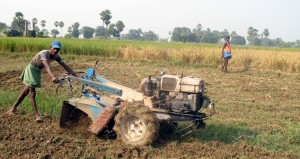The Mushar people are amongst the poorest of the world’s poor. If you search the web, you’ll find descriptions of these people that range from encyclopaedic to heartbreaking. Their problem is not just that they are poor. They also live in the poorest state in India. Worst of all, they are considered “untouchables” in the Hindu caste system.

As this encyclopedia points out, if a Mushar gains property, it will quickly be taken away. If his child gains a place in a multi-ethnic school, she will quickly be forced out. “They are powerless and voiceless, unable to change their situation alone”. Other web pages talk about the assistance being provided to the Bihar – for example, this Nepalese organization has set up a Mushar primary school in southern Nepal with a Mushar teacher. One school is not much amongst over 2.6 million people, however, and only 3 out of every 100 Mushar know how to read.
However, the Mushar have some amazing mathematical skills shared by almost no other people in the world.
The word “Mushar” means “mouse-eater”. Depending what resource you look up, they eat rats and mice either out of desperation or as a delicacy. Maybe it’s both. there are 10000 in Bangladesh, a quarter of a million in Nepal, and ten times that many in India. Like all people everywhere, rich or poor, they have their own language, cuisine, culture, songs and poems. Here’s a sample of one of their poems…
take take haari / paanchi take bhaari / take ke bees go tuiyaan / sau saaman sau rupaiya
of course, you’d like the translation
one object for one rupee / another for five / 20 of the third for one rupee / 100 objects for 100 rupees
That’s right, this virtually uneducated people, living in abject poverty, despised by all their neighbours, tell each other math puzzle poetry. Can you solve the puzzle? Three objects cost $1, $5 and 5c each respectively. You buy 100 objects for $100. How many of each do you buy?
This amazing feature of these people was explored by Arindam Bose from TIFR, a research institute in Bombay set up by one of India’s largest companies. Here’s another poem he learned from the Mushar :
The teacher weighs 9 maun / his wife weighs the same / 2 students together weigh 9 maun / the boat can carry 9 maun / how do they cross the river?
The Mushar challenge each other with math puzzles as part of their normal activities. They develop an intuition for numbers that enables them to quickly solve arithmetic problems in their head. Their ability with numbers is oral – they are unfamiliar with written mathematics. Here’s how an illiterate Mushar worked out 16×4 :
… double 15 is 30, double of 30 is 60. Add 4 to it, that’s 64. So 64 is the answer…
They have an intuitive grasp of numbers, and know tricks to simplify problems they have to solve. One, when asked “If cloth is 25 rupees per metre, how much for three-quarters of a metre?” answered
Twelve and a half rupees plus six and a quarter, that’s eighteen and three quarters.
The Mushar don’t recognize what they do as mathematics. What’s more, beginning formal schooling tends to blunt their intuitive approach – unschooled Mushar can solve these problems faster than (better educated) school dropouts. The things that make them so good include :
- a long history of mathematical riddles and puzzles
- changing the numbers in multiplication problems into ones they find more convenient
- experience and practice
- confidence in their abilities
- keeping track of “where they are” in a calculation
Some of the Mushar’s responses to Arindam Bose’s questions show that the “arithmetical tricks” they use might be very different from what we might use. This (and other things) lead Arindam to wonder if educational methods invented in one cultural context might be inappropriate for others – whether an educational style that works fine for one culture might fail completely for another. An uneducated Mushar man was asked to compute 35×10.
3 times 35 gives 105. One more 105 gives 210. So, umm.. 6 so far, four left. Take one more 105, and that’s 315. Now, that’s 9. So, add one more 35. That’s 35. That’s the full 10. Yes, yes, the answer should be 350.
One could try to teach the man about adding a zero. However, this man does not know how to read or write numbers. “Adding a zero” would make no sense for him – and he already knows how to solve the problem.
Think about the Mushars next time you are wondering how best to teach uninterested students. Perhaps there’s some creative way to get the point across that goes askew of formal educational methods? Let me close with two more puzzles from the Mushar – perhaps you can challenge your own kids or students with it… or yourself!
A bird has two birds in front / a bird has two birds behind / tell, tell, how many birds?
3 animals / cows, buffaloes, goats / cows give half a kilo of milk / buffalos 4 kilos and goats a quarter / 20 animals needed, and 20 kilos of milk / how many of each animal will you take?
One thought on “The Mouse-Eating Geniuses of Bihar”
Comments are closed.